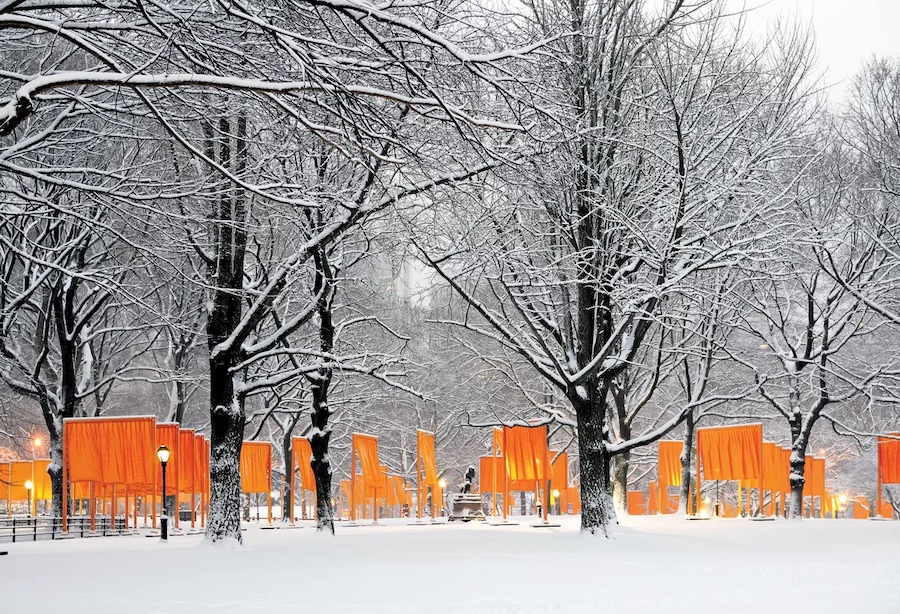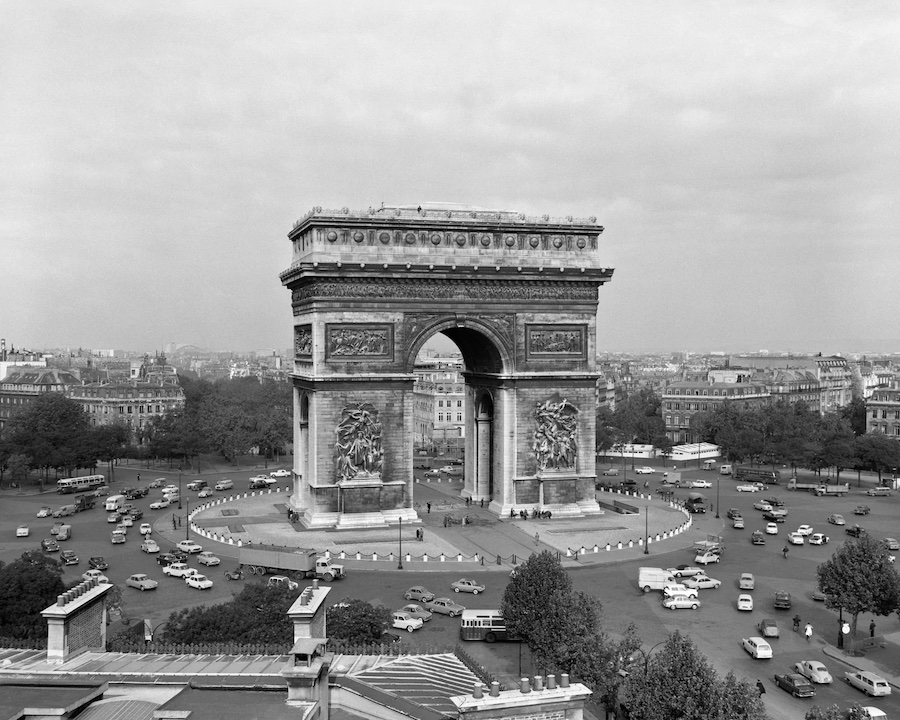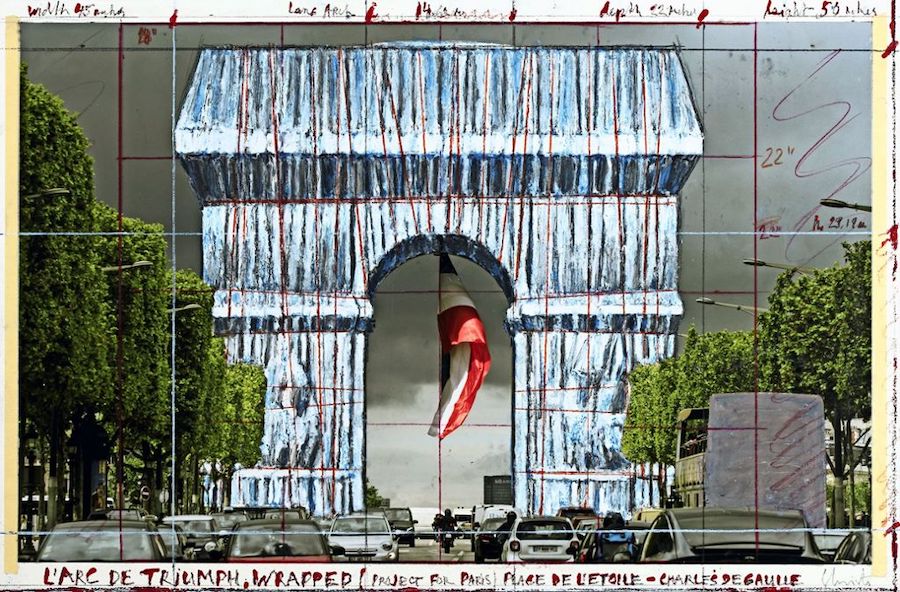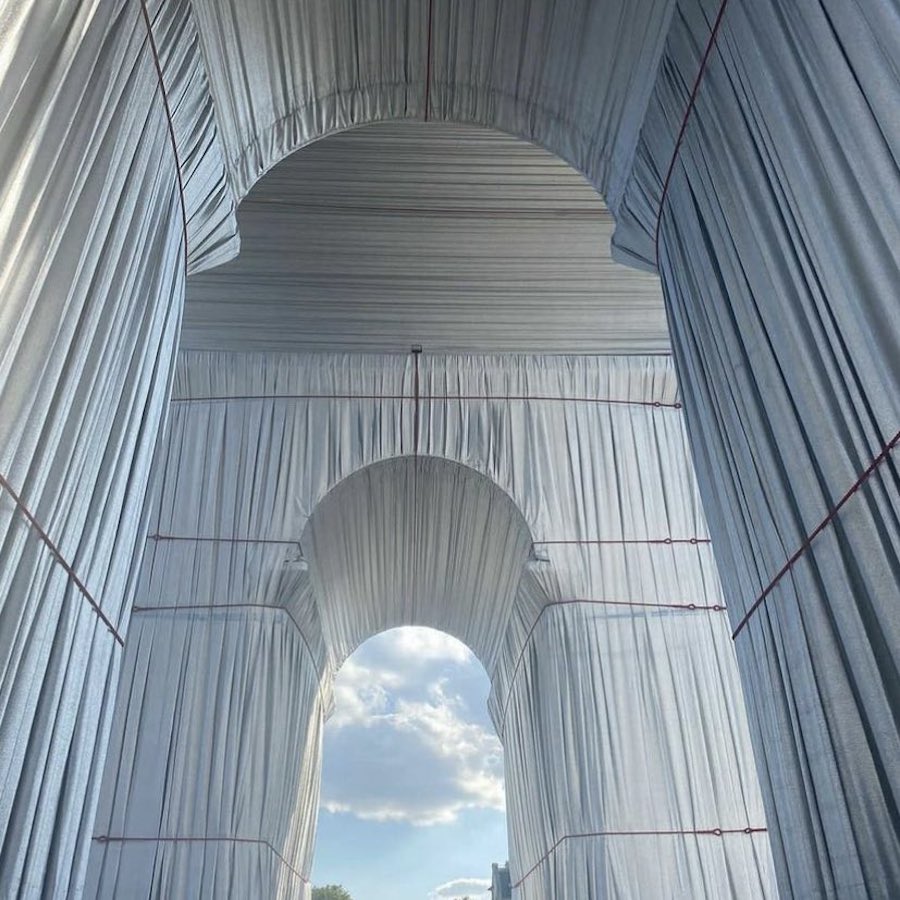It has been 62 years since a young artist, recently arrived in Paris having fled from communist Bulgaria stowed away in a train carriage, began painting sketches with the dream in mind of one day wrapping the Arc de Triomphe in Paris. That young visionary along with Jeanne-Claude Guillebon, his wife and other half in life and in art, are no longer with us, she having died in 2009
Preparatory drawing for the Arc de Triomphe installation in Paris (2019)
It has been 62 years since a young artist, recently arrived in Paris having fled from communist Bulgaria stowed away in a train carriage, began painting sketches with the dream in mind of one day wrapping the Arc de Triomphe in Paris. That young visionary along with Jeanne-Claude Guillebon, his wife and other half in life and in art, are no longer with us, she having died in 2009 and he on 31st May 2020 in New York, shortly before his 85th birthday. But this coming 18th September, and over 16 days, the Arc de Triomphe will, at last, be veiled in 25,000 square metres of silver blue fabric fastened with three kilometres of red ribbon rope. Everything had been measured out, drawn up and written down by its creators.
Christo Vladimirov Javacheff was born on 13th June 1935 in Gabrovo, Bulgaria and that same day in Casablanca, Morocco, Jeanne-Claude Guillebon was born. Above all else, Christo and Jeanne-Claude symbolise a love story that lasted the entirety of their lives. Between 1953 and 1956, he studied ‘Socialist Realism’, as mandated by the state, at the Academy of Fine Arts in Sofia. He was so precociously and highly gifted a draughtsman that his mother insisted he have drawing lessons from the age of six. He fled communist Bulgaria in 1957 for Paris, a city that he had chosen as his destiny from the outset. There, he made ends meet for the first few years by painting portraits of the upper classes. In March 1958, a few months after his arrival, he met Jeanne-Claude who came from a military family with little connection to the world of contemporary art but who adapted to his life with enthusiasm, intelligence and passion. From 1961, they began working together and, this same year, on the occasion of their first solo exhibition in Cologne (Germany), they mounted their first temporary installation at the city’s port. Christo, at that time in the grips of an obsession, was wrapping everything up, even his wife's high heels. Those pieces would become the catalyst for the spectacular environmental interventions we know today. As of 1964, they settled in New York.

Christo and Jeanne Claude in their New York studio with sketches of Surrounded Islands in the background (1981)
Jeanne-Claude's contribution has often been described as the mere administration of contracts and sales yet it was much more than just that. Such was the passion both she and her husband felt for their joint work, they would travel on different planes so that, in the event of one’s crash, the other could continue to fulfil their destiny.
They dedicated more than 50 years to encasing landmarks and landscapes in cloth - ephemeral works that captured the imagination of the whole world. However, Christo has said that they never thought about the impact their work would have on generations of artists to come - a humble claim for a legacy like theirs, among the first artists ever to leave traditional gallery space and take their work as far away as the Australian coast and the German parliament. They wrapped valleys in curtains, covered islands in drapes and braided fabrics between bridges. Nothing seemed unconquerable.

Surrounded Islands, Bay of Biscayne, Florida (1980-1983)
The profound and loaded significance of the word "freedom" was undoubtedly the beacon guiding all their projects and the key to their work as well as their lives. "I was really drowning in that horrible Soviet regime. I couldn't give up an inch of my freedom," Christo said. "All these projects are completely irrational, completely useless. No one needs them. They can’t be bought. They exist in their time, impossible to be repeated. That is their power."
In order to explain their work, former refugee Christo has said that he considered all of their creations to have been marked by nomadism. "The fabric is the main element to transmit this. The projects have many complex parts but the fabric is a quick thing to assemble, like the Bedouin tents in nomadic tribes."

The Gates, Central Park, New York (February 2005)
From their home in New York shortly before his death, Christo stressed that their works, despite being temporary, are not performances - they are sculptures that cannot be owned. In that sense, he mocked the art market and its most recent, grandiose productions. Granted, all of the preparatory drawings and materials have been put up for sale over the years but self-financing was always their sole modus operandi. Despite each work requiring huge sums of money and employing hundreds of people, this allowed them to fly free and far from the bonds of any concessions, impositions or patrons.

Running Fence, Sonoma, California (September 1976)
The only dues Christo and Jeanne-Claude incurred were in the form of the permits they had to obtain - bureaucratic battles lasting years and taking its toll on many of their illusions, but Christo thought this journey helped gestate their pieces: "The work of art reveals itself little by little throughout the process of getting permits." Many attempts failed. Despite Jeanne-Claude's gift for negotiation, 23 projects saw completion over the years but 47 did not.
Among the projects they did succeed in realising was 1983's "Surrounded Islands", eleven of them ringed by rivers of pink cloth in Miami’s Biscayne Bay. Also in 1985, they completed their first major project in Paris - covering the capital’s oldest bridge, the Pont Neuf, in fabric after many months of dispute with the mayor at the time, Jacques Chirac, as detailed in the fascinating documentary "Christo in Paris".

Pont Neuf, Paris (1985)
Between 24th June and 7th July 1995, their then most ambitious work, “Germany”, was installed in Berlin. In the space of two weeks, five million people from around the world came to see the Reichstag wrapped. This installation transformed the seat of German politics after its reconstruction by Norman Foster who added the famous glass dome. Christo and Jeanne Claude had fought for 23 years to get the permits and on 23rd June, the plastic panels shielding it were removed - some 100,000 metres of fabric tied round with ropes one kilometre long to make the outline of the building visible. Christo said that, until 1989, the Reichstag had been a mausoleum, a sleeping beauty that they had reawakened. The building fascinated him as a symbol of freedom and its wrapping proved to be an astonishing feat of technology. David Bourdon, Christo's biographer, defined the Bulgarian artist's philosophy of art as "revealing something by hiding it."

Wrapped Reichstag, Germany (July1985)
After the Reichstag would come "The Gates" (2005), a 23-mile route through New York's Central Park dotted with 7,503 doorways hung with saffron-coloured panels blowing in the wind. And, more recently, "Floating Piers" (2016), comprising three kilometres of floating pontoons on Lake Iseo (Bergamo, Italy).

Arc de Triomphe, Place de l’Étoile, Paris (1963)
At the time of his death, Christo had another project in the pipeline – the wrapping of the Arc de Triomphe in Paris, an intervention that had to be postponed until September 2021 due to the outbreak of Covid 19. Concurrently, the Pompidou Centre held an exhibition dedicated to the work of Christo and Jeanne-Claude and focusing on their French projects.
The plans for the Arc de Triomphe were approved in just one year: "Thank you to the young President," said Christo, referring to Macron, but when asked if this was a sign of greater understanding and acceptance of his work in France, he replied with a loud and unequivocal "No!" and went on to explain that "For each project, we have a thousand people trying to help us and another thousand trying to stop us". Running in tandem was an exhibition at Madrid’s Guillermo de Osma Gallery paying tribute to this marriage of artists and featuring fifteen drawings associated with Christo and Jeanne-Claude’s installation projects.
Preparations for L'Arc de Triomphe Wrapped, Paris (20 July 2021)
The Arc de Triomphe, with its huge historical significance, was built between 1806 and 1836 to celebrate France’s victory at the Battle of Austerlitz under Napoleon’s command and fulfilling this promise to his men - "You will return home through arches of triumph". Measuring 49 m high and 45 m wide, it was designed by Jean Chalgrin along with Jean-Arnaud Raymond and inspired by the Arch of Titus in Rome. It sits on a hill crowned by the Place de l'Étoile from which radiate twelve avenues designed in the 19th century by Baron Haussmann. The historic war portal, with its iconic bas-reliefs and famous "The Departure of the Volunteers of 1792" sculpted by François Rude, will see its old silhouette spruced up for 16 days. Twice as many metres of fabric as its surface area will be used: "What we propose is a new structural dimension thanks to this beautiful fabric," Christo said. A project of this magnitude will require the labour of around a thousand people and "It will not be something static; it will be like a living being which will move with the wind; it will not be something made of bronze, nor bricks. It will be something that transmits the play of wind and sunlight," he said, inviting us to dream his dream.
Because what is compelling about these artists was their ability to force the spectator to become newly aware of an environment they had grown so accustomed to looking at, it had become invisible. It is by concealing it that it takes on the prominence it deserves. And so, now, Napoleon's Arc de Triomphe will once again be the arch celebrating another conquest - that of Christo and Jeanne Claude's work of wrapped art with its scaffolding nailed, this time, to the sky.
Christo & Jeanne Claude 1960-1970
Galería Guillermo de Osma
Claudio Coello, 4
Madrid
9 September - 15 October 2021
Translated from the Spanish by Shauna Devlin
- Christo & Jeanne-Claude: Wrapping The Arc de Triomphe - - Alejandra de Argos -






